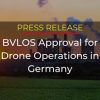The move towards autonomous technology is driving the demand for streamlined regulatory approval processes. Percepto is working with regulators worldwide, setting standards and paving the way for a truly autonomous future.
It’s in the DNA of regulators to react with an abundance of caution in the face of emerging technologies – and has been for well over a century. In the late 1800’s, for example, newly-popular automobiles in the UK and some US states were subject to “red flag laws” – requiring someone carrying a red flag (or a lantern, if it was dark) to run in front of all self-propelled vehicles, warning of their approach. These quirky laws were quickly repealed and replaced as regulators realized – and acted to mitigate – the actual risks associated with automobile travel.
The same thing is happening with commercial drones today. Drone flight remains highly-regulated, and rightfully so. Regulators are understandably concerned about drones flying over people, operating remotely and in darkness or inclement weather, and – critically – the dangers of uncoordinated flights interfering with other aircraft. That’s why regulators tend to approve drone flights in any of the aforementioned conditions on a case-by-case basis, especially for autonomous drone flights.
Increased public trust in autonomous technology and quantum leaps in the safety of autonomous drones – which in many ways are safer than piloted drones – are driving regulatory change. Moreover, the Covid-19 pandemic surfaced an acute need for remote operations when on-site workforce availability is limited – and this is driving demand for streamlined regulatory approvals for autonomous drone flight. Today, leading drone vendors, like Percepto, are managing to move the regulatory needle forward towards fully-autonomous drone flights as an industry standard.
BVLOS is on the Horizon
Of all the above-mentioned regulatory approvals, the most challenging to receive is BVLOS (Beyond Visual Line of Sight), which means different things according to different regulatory bodies. In many countries, for instance, the majority of BVLOS approvals granted include a requirement to have an observer on the ground to deconflict the airspace during drone flight.
BVLOS is the key to unlocking the full ROI of autonomous drone flight. While non-BVLOS autonomous drone flights already deliver substantial value by automating flights and providing consistent and persistent monitoring of the site, the advantages of truly autonomous BVLOS flights are clear – especially in today’s climate where human reach is frequently limited by stay-at-home requirements. These advantages include reduced costs and overhead with no need for trained drone pilots or observers on the ground, and affordable 24/7/365 remote operations that enable enhanced aerial perception – generating more accurate data and more actionable insights.
Autonomous drone advantages, along with significant safety improvements, are beginning to ease the path to BVLOS waivers for experienced and proven providers like Percepto. Such safety solutions range from software reliability features for errors like GPS loss and communication disruptions, and platform safety enhancements such as an integral emergency parachute. By removing the human-error factor and integrating advanced safety solutions, regulators find a new BVLOS comfort zone.
Global BVLOS Regulatory Snapshot
Here’s what we’re seeing across the globe:
-
- United States – The Federal Aviation Administration (FAA) issued official rules for small unmanned aircraft operations in 2016 in their Part 107. In 2019 the industry pressure to open the airspace to the incorporation of small drones reached an all-time high, which led to the FAA’s D. More recently, we’ve seen an uptick in the number of Part 107 waivers granted for autonomous BVLOS flights.
- Australia – The Australian Civil Aviation Safety Authority (CASA) is moving towards widespread and streamlined approvals for BVLOS operations in the framework of its Specific Operations Risk Assessment (SORA) program. Notably in remote Australia (which comprises some 90% of the country), the program enables drone operators to reach agreements with entities who share regional airspace, eliminating the need for visual observers and paving the way for widespread autonomous drone operations.
- European Union / UK – The EU has released a new directive specifying the guidelines for BVLOS operations, and member countries are working on implementing them into their local regulations accordingly. The UK recently released new regulations allowing for a clear path to approved BVLOS operations for small drones.
- Canada – Transport Canada has introduced rules that pave a path forward for approval of advanced drone operational modes, including BVLOS operations. Relying heavily on cooperation between applicants and the regulator, the authority has established test sites throughout Canada where applicants can perform system demonstrations as part of the BVLOS approval process.
- Rest of World – In many countries, BVLOS regulations are still emerging. Some countries, like Mexico, take a rather permissive stance regarding the use of autonomous drones – enabling unregulated usage over private property. Others throughout Latin America and Asia demand specific approvals for BVLOS operations.
Percepto at the Forefront
The Percepto system is already active across four continents and 10 countries and has received numerous regulatory approvals and BVLOS waivers to operate autonomously. Percepto works closely with regulators around the world, engaging in drone programs that are shaping the future of drone regulation and sitting shoulder to shoulder with organizations like Wing and Amazon. We leverage a deep understanding of the regulatory mindset and processes to support our customers in receiving the approvals they need. Achievements we’re especially proud of include:
- US – We have received several BVLOS waivers, including the first such waiver granted to a utility company.
- Australia – Percepto’s Australian clients operate our drones from a control room, without the need for a licensed pilot on the ground.
- Italy & Portugal – Percepto has received first-of-its-kind BVLOS waivers in both countries.
- Israel – One of the more challenging airspaces in which we operate, Percepto was the first company to receive a BVLOS waiver at an Israeli industrial site.
And the list goes on…
The Bottom Line
Percepto has gained much valuable experience working with regulators around the world to enable fully-autonomous drone operations while still maintaining the highest levels of safety and accountability. In many countries, we were first to receive BVLOS approvals as well as approvals to operate at night and above people. We also continue to consult with new and existing customers to assist them in obtaining waivers from the regulatory bodies in their respective countries.
Promoting better BVLOS standards and greater regulatory understanding is helping Percepto take autonomous drone usage – and the autonomous drone industry – to the next level, which will enable companies to better adjust to the ‘next normal’ that calls for increasing the portion of remote operations.





